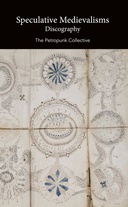Explore

Speculative Medievalisms
Eileen A. Joy (editor), Anna Klosowska (editor), Nicola Masciandaro (editor), Michael O’Rourke (editor), Kathleen Biddick, Jeffrey Jerome Cohen, Graham Harman, J. Allan Mitchell, Kellie Robertson, Anthony Paul Smith, Nick Srnicek, Eugene Thacker, Scott Wilson, Julian Yates, Liza Blake, Patricia Clough, Drew Daniel, Ben Woodard
2013
0 Ungluers have
Faved this Work
Login to Fave
Proceedings from the two Speculative Medievalisms symposia, held at King’s College London (Jan. 2011) and The Graduate Center, City University of New York (Sep. 2011), and organized by The Petropunk Collective (Eileen Joy, Anna Klosowska, Nicola Masciandaro, and Michael O’Rourke). These interdisciplinary events were dedicated to dialogue and cross-contamination between traditional concepts of speculatio, present-minded premodern studies, and contemporary speculative realist and object-oriented philosophies. In its medieval formulation, speculatio signifies the essentially reflective and imaginative operations of the intellect. Here the world, books, and mind itself are all conceived as specula (mirrors) through which the hermeneutic gaze can gain access to what lies beyond it. “To know is to bend over a mirror where the world is reflected, to descry images reflected from sphere to sphere: the medieval man was always before a mirror, both when he looked around himself and when he surrendered to his own imagination” (Giorgio Agamben, Stanzas). Correlatively, speculative realism, as the term suggests, is characterized by the self-contradictory intensity of a desire for thought that can think beyond itself — a desire that proceeds, like all philosophy, in a twisted and productive relation to the phantasm of the word.Aiming to rise above and tunnel below the thought-being or self-world correlation, speculative realism “depart[s] from the text-centered hermeneutic models of the past and engage[s] in daring speculations about the nature of reality itself” (The Speculative Turn). Speculative Medievalisms, like some weird friar-alchemist in an inexistent romance, plays the erotic go-between for these text-centered and text-eccentric intellectual domains by trying to transmute the space between past and present modes of speculation from shared blindness to love at first sight. Possibly succeeding, the volume brings together the work of a motley crew of philosophers and premodernists into prismatic relation.
This book is included in DOAB.
Why read this book? Have your say.
You must be logged in to comment.
